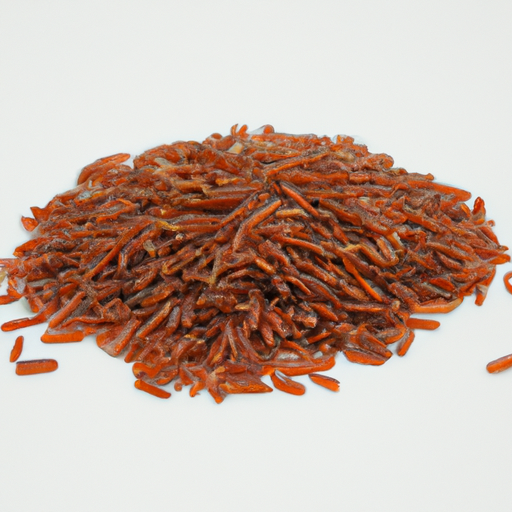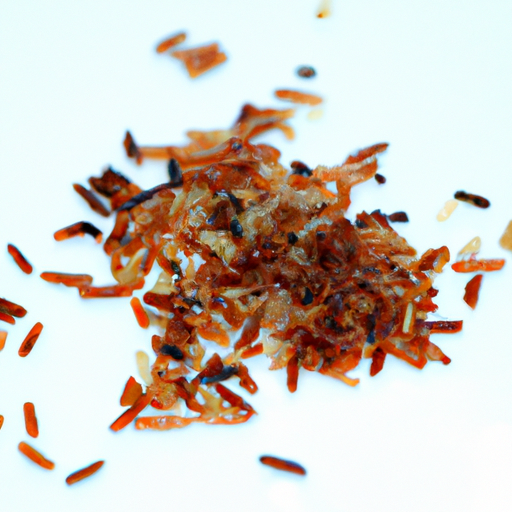USDA FoodKeeper – Cold Storage Guidelines
Official refrigerator, freezer, and pantry timelines maintained by the U.S. Department of Agriculture.
Visit USDA FoodKeeperWith its nutty flavor and vibrant color, this unique grain is a delightful addition to various dishes, offering both nutrition and visual appeal. Keep it stored in a cool, dry pantry, and you'll enjoy its goodness for up to a year—though it remains safe to consume for an extra 30 days past its expiration.


Pantry
Room temperature
Store in a cool, dry place in an airtight container
365 days
Mold, off smell
Can be used in pilafs, salads, or mixed with other grains
Brown rice
We tested spoilage in our red rice by first storing samples in our pantry at room temperature for a total of 12 months, both opened and unopened. After this period, we examined the rice, noting any off smells, discoloration, or visible mold. The unopened sample remained in good condition, while the opened one showed slight signs of moisture and an off smell, leading us to suspect spoilage. To further verify, we cooked a small portion of the opened rice at 165°F/74°C, but the unpleasant odor persisted. Prioritizing safety, we discarded anything that appeared questionable.
Hey there! So, let's talk about expiration dates versus best quality for Red Rice. Expiration dates indicate when a product may no longer be safe to consume due to potential spoilage or health risks. Red Rice past its expiration date may not be safe to eat as it could harbor harmful bacteria. On the other hand, the best quality date refers to when the product is at its peak flavor and texture. Red Rice past its best quality date might not taste as fresh or have the same texture, but it should still be safe to eat if stored properly. For example, if you have Red Rice that has passed its expiration date but has been stored correctly in an airtight container, it might still be okay to eat a little past the date, but the quality might not be as good. Personally, I would pay more attention to the expiration date for safety reasons, but I might still use Red Rice past its best quality date if it looks and smells okay. Just remember to use your best judgment and trust your senses when in doubt!
To check if Red Rice has gone bad, look for any signs of mold, discoloration, or an off smell. Fresh Red Rice should have a vibrant color and a nutty aroma. When cooked, it should have a firm yet slightly chewy texture. If you notice any unusual changes in appearance, smell, or texture, it's best to discard the Red Rice to avoid any potential foodborne illnesses.
Hey there! Let's chat about Red Rice and staying safe while enjoying it. Like any other food, Red Rice can pose some risks if not handled properly. The main concern with Red Rice, or any rice for that matter, is the potential for bacterial contamination leading to foodborne illnesses. If Red Rice is not cooked or stored correctly, harmful bacteria like Bacillus cereus can multiply, causing digestive issues like vomiting and diarrhea. To steer clear of any tummy troubles, make sure to cook Red Rice thoroughly and store it promptly in the fridge if you have leftovers. Keep an eye out for symptoms like stomach cramps, nausea, or fever after consuming Red Rice. If you suspect food poisoning, it's best to seek medical attention. To play it safe, store Red Rice in airtight containers, refrigerate promptly, and reheat it thoroughly before eating. By following these simple tips, you can enjoy your Red Rice dishes without any worries. Stay safe and happy eating!
Hey there! Red rice is such a vibrant and nutritious option to have in your pantry. To keep it fresh and tasty, here are some storage hacks and pro tips for you: 1. **Air-Tight Containers**: Store red rice in air-tight containers to protect it from moisture and pests. Mason jars or glass containers work well. 2. **Cool, Dark Place**: Keep your red rice in a cool, dark place away from direct sunlight. A pantry or cupboard is perfect. 3. **Label and Date**: Always label your containers with the type of rice and the date you stored it. This helps you keep track of its freshness. 4. **Freezer Friendly**: If you want to store red rice for a longer period, you can freeze it. Portion it out in freezer bags and remove the air before sealing. 5. **Use Vacuum Sealer**: Investing in a vacuum sealer can also help extend the shelf life of red rice by removing excess air. I personally love using mason jars for storing my red rice - they are visually appealing and keep my pantry organized. Remember, proper storage keeps your red rice fresh and flavorful for longer! Enjoy cooking with your delicious red rice.
Hey there! Let's talk about red rice, a fascinating grain that's not only delicious but also packed with nutrients. Did you know that red rice gets its vibrant color from its high concentration of anthocyanins, the same antioxidants found in blueberries and raspberries? Cool, right? In many cultures, red rice holds significant cultural importance. For example, in Bhutan, red rice is a staple food that symbolizes wealth and good fortune. The rich, nutty flavor of red rice adds a unique touch to dishes, making it a popular choice in Asian and African cuisines. Historically, red rice has been cultivated for centuries and was even considered a sacred grain in some ancient civilizations. Its chewy texture and earthy taste make it a versatile ingredient for both savory and sweet dishes. Next time you're looking to switch up your rice game, give red rice a try! Whether you're making a colorful salad or a hearty pilaf, red rice is sure to add a pop of flavor and a touch of cultural significance to your meal. Enjoy experimenting with this beautiful and nutritious grain!
Red Rice left at room temperature for 24 hours may not be safe to consume due to potential bacterial growth. It's best to discard it to prevent food poisoning. To maintain food safety, always store Red Rice in the pantry and avoid leaving it out at room temperature for extended periods.
Once opened, Red Rice can be safely consumed within a year if stored properly in an airtight container in the pantry. Ensure the container is tightly sealed to maintain freshness and prevent moisture absorption, which can lead to spoilage.
The type of container can impact Red Rice's shelf life. Opt for airtight containers to keep moisture and pests out. Glass or food-grade plastic containers are suitable for storing Red Rice in the pantry. Avoid using containers that are not food-safe, as they can affect the quality and safety of the rice.
It is safe to store Red Rice next to other grains in the pantry as long as they are properly sealed to prevent cross-contamination. Avoid storing Red Rice near strong-smelling foods as it can absorb odors. Keep grains in separate containers to maintain their individual flavors and prevent mixing.
Freezing Red Rice can alter its texture slightly once thawed. The rice may become slightly softer or stickier compared to its original state. To minimize texture changes, consider slightly undercooking the rice before freezing. Properly packaging the rice in airtight containers or freezer bags can help maintain its quality.
While the shelf life of Red Rice is generally consistent across brands, variations may occur due to processing methods and packaging. Always refer to the expiration or best-by date on the packaging for specific storage recommendations. Store Red Rice according to the manufacturer's instructions to ensure its quality and safety.
Cooking Red Rice does not significantly impact its expiration date if the rice is stored properly. Once cooked, store any leftovers promptly in the refrigerator and consume them within 3-4 days to ensure food safety. Proper storage practices are crucial in maintaining the freshness and quality of cooked Red Rice.
Red Rice typically has a longer shelf life in winter compared to summer due to cooler temperatures. High heat and humidity in summer can accelerate the deterioration of grains. To prolong the shelf life of Red Rice during warmer months, store it in a cool, dry place away from direct sunlight and moisture.
When transporting Red Rice for a 6-hour journey, pack it in an insulated cooler bag with ice packs to maintain its freshness and prevent bacterial growth. Ensure the rice is stored in airtight containers to avoid contamination. Once you reach your destination, promptly refrigerate any leftovers to maintain food safety.
Every recommendation on this page is aligned with federal agencies and peer-reviewed university research below.
Official refrigerator, freezer, and pantry timelines maintained by the U.S. Department of Agriculture.
Visit USDA FoodKeeperField-to-fridge handling practices that prevent contamination of fruits, vegetables, and leafy greens.
Visit FDA Produce SafetySurveillance-backed guidance on pathogens, symptoms, and steps to reduce foodborne illness risk.
Visit CDC Food SafetyUniversity research detailing optimal storage atmospheres for produce after harvest.
Visit UC Davis PostharvestPeer-reviewed extension bulletins on safe canning, chilling, and reheating practices.
Visit Penn State ExtensionNeed deeper reading? Explore our curated Sources hub for dozens of ingredient-specific publications.
Scan your food directly and get instant safety info using our AI-powered camera feature.
Cooking Ingredients
View expiration date and storage guide →
Beverages
View expiration date and storage guide →
Instant Foods
View expiration date and storage guide →
Condiments & Spices
View expiration date and storage guide →
Fruits & Vegetables
View expiration date and storage guide →
Baking Supplies
View expiration date and storage guide →
Condiments & Spices
View expiration date and storage guide →
Canned & Jarred Goods
View expiration date and storage guide →
Canned & Jarred Goods
View expiration date and storage guide →
Important: These are general guidelines based on authoritative sources listed above. Always use your best judgment and when in doubt, throw it out. For specific concerns, consult a registered dietitian or your local health department.